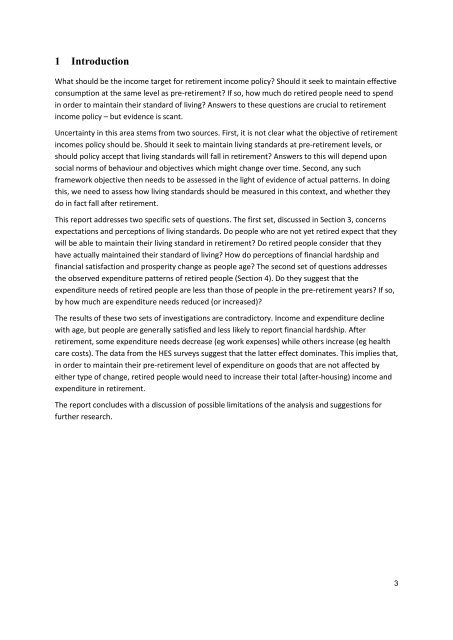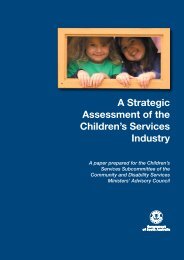Perceptions and Expenditure Patterns - Social Policy Research ...
Perceptions and Expenditure Patterns - Social Policy Research ...
Perceptions and Expenditure Patterns - Social Policy Research ...
You also want an ePaper? Increase the reach of your titles
YUMPU automatically turns print PDFs into web optimized ePapers that Google loves.
1 IntroductionWhat should be the income target for retirement income policy? Should it seek to maintain effectiveconsumption at the same level as pre-retirement? If so, how much do retired people need to spendin order to maintain their st<strong>and</strong>ard of living? Answers to these questions are crucial to retirementincome policy – but evidence is scant.Uncertainty in this area stems from two sources. First, it is not clear what the objective of retirementincomes policy should be. Should it seek to maintain living st<strong>and</strong>ards at pre-retirement levels, orshould policy accept that living st<strong>and</strong>ards will fall in retirement? Answers to this will depend uponsocial norms of behaviour <strong>and</strong> objectives which might change over time. Second, any suchframework objective then needs to be assessed in the light of evidence of actual patterns. In doingthis, we need to assess how living st<strong>and</strong>ards should be measured in this context, <strong>and</strong> whether theydo in fact fall after retirement.This report addresses two specific sets of questions. The first set, discussed in Section 3, concernsexpectations <strong>and</strong> perceptions of living st<strong>and</strong>ards. Do people who are not yet retired expect that theywill be able to maintain their living st<strong>and</strong>ard in retirement? Do retired people consider that theyhave actually maintained their st<strong>and</strong>ard of living? How do perceptions of financial hardship <strong>and</strong>financial satisfaction <strong>and</strong> prosperity change as people age? The second set of questions addressesthe observed expenditure patterns of retired people (Section 4). Do they suggest that theexpenditure needs of retired people are less than those of people in the pre-retirement years? If so,by how much are expenditure needs reduced (or increased)?The results of these two sets of investigations are contradictory. Income <strong>and</strong> expenditure declinewith age, but people are generally satisfied <strong>and</strong> less likely to report financial hardship. Afterretirement, some expenditure needs decrease (eg work expenses) while others increase (eg healthcare costs). The data from the HES surveys suggest that the latter effect dominates. This implies that,in order to maintain their pre-retirement level of expenditure on goods that are not affected byeither type of change, retired people would need to increase their total (after-housing) income <strong>and</strong>expenditure in retirement.The report concludes with a discussion of possible limitations of the analysis <strong>and</strong> suggestions forfurther research.3
















